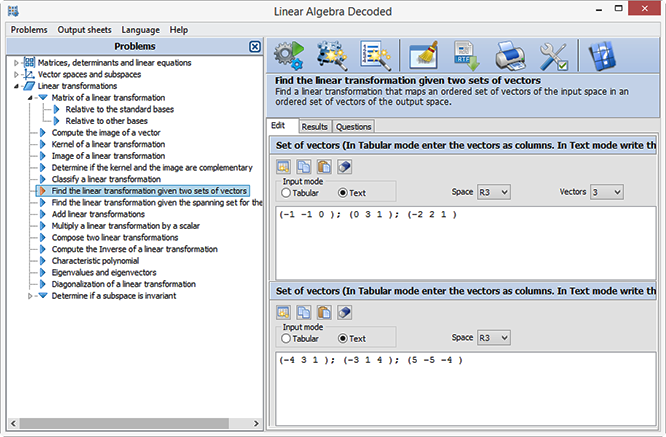When we talk about vectors, the first idea is to relate this concept to Euclidean vectors, and it is very common that in Linear Algebra books and tests, most of problems related to Vector Spaces and Linear transformations deal with Euclidean spaces Rn, but sometimes, there are exercises that involve working with other sets like matrices, polynomials and functions, because, as it is well known, these sets are also Vector Spaces.
Linear Algebra Decoded only deals with Euclidean vector spaces, but it is easy to work with other vector spaces such as polynomials. In this post we will discuss how to use Linear Algebra Decoded to solve problems that use the set of polynomials as vector spaces.
As it has been proven in Linear Algebra, every n-dimensional real vector space is isomorphic to Rn, and as the Vector Space of polynomials of degree n or less (Pn), has dimension equal n+1, this vector space is isomorphic to Rn+1, which means that these two vector spaces have similar properties with respect to the fundamental linear algebra operations of vector addition and scalar multiplication, and in consequence, Pn can be recast in terms of Rn+1.
Every polynomial p in Pn can be written as:
p=p(x)=a0 + a1x + a2x2 + ... + anxn
The set of standard basis vectors for Pn is {1, x, x2, ..., xn}. Vector p can be described by writing it in terms of the coordinates respect to the standard basis: (a0, a1, a2, ..., an), which corresponds to the Euclidean space Rn+1. This leads us to the linear transformation T: Pn -> Rn+1:
T(a0 + a1x + a2x2 + ... + anxn) = (a0, a1, a2, ..., an)
Which can be easily proven is an isomorphism.
So, instead of working with Pn we can translate polynomials from Pn to (n+1)-dimensional Euclidean vectors, solve the problem, and then translate the answer to the set of polynomials, if necessary, using the inverse of T, that is:
T-1((a0, a1, a2, ..., an)) = a0 + a1x + a2x2 + ... + anxn
Let's see a practical example and how to solve it using Linear Algebra Decoded.
Find a linear transformation that maps each polynomial of the base of P2 {-1 - x, 3x + x2, -2 + 2x + x2}, into the respective polynomials of P2 {-4 + 3x + x2, -3 + x + 4x2, 5 - 5x - 4x2}.
To solve this problem using Linear Algebra Decoded, we first transform the problem to its equivalent R3 problem, which could be rewrite as:
Find a linear transformation that maps each vector of the base of R3 {(-1 -1 0), (0 3 1), (-2 2 1)}, into the respective vectors of R3 {(-4 3 1), (-3 1 4), (5 -5 -4)}.
And use the right problem in Linear Algebra Decoded list of problems, in this case: Find the linear transformation given two sets of vectors.

For this problem, which also covers cases when the input vectors is not a basis, the software will check it is a basis, and will avoid doing other steps. Later it will compute the inverse of the matrix of the basis (B), which is:
┌ ┐
│ 1 -2 6 │
Inv(B) = │ 1 -1 4 │
│ -1 1 -3 │
└ ┘
Then, it will multiply the matrix of the output vectors U by the inverse of the basis matrix B.
┌ ┐
│ -12 16 -51 │
U•Inv(B) = │ 9 -12 37 │
│ 9 -10 34 │
└ ┘
Where the resulting matrix is the matrix of the Linear Transformation:
f(x, y, z) = (-12x+16y-51z, 9x-12y+37z, 9x-10y+34z)
We need to translate the result, to a Linear Transformation from P2 to P2, which can be done, easily:
f(a0+a1x+a2x2)=(-12a0+16a1-51a2)+(9a0-12a1+37a2)x+(9a0-10a1+34a2)x2
As you can see it's very easy to use Linear Algebra Decoded to solve problems of Vector Spaces and Linear Transformations that involve Polynomials instead of Euclidean Vectors. If you have any questions, please, use the comments to ask us, and we will respond to you with pleasure.
Related posts







Your comment